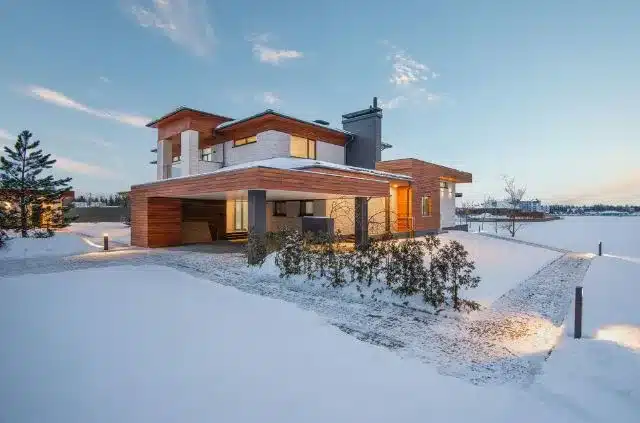Your home is your biggest investment. You decorate your home, take care of it, and protect it from all kinds of tough conditions. It’s important to secure and protect your home since it’s one of your largest investments. Your home is up against a lot, and the best-known threat is the elements, like fire and floods. By far, winter plays a harsh reality for your home. Since the extreme cold can be unforgiving on your house, discover four ways to protect your home from the winter season.
Practical Tips To Winter-Proof Your Home Now

Short on home renovation ideas for winters that are affordable and effective? Scroll and get complete guidance to protect your home when the temperature drops.
1. Get a Roof Inspection Before Winter
Your roof is a vital piece of the structure of your home. A faulty roof means higher electric bills, leaks, and pricey repair costs. Can your roof bear the weight of an average of four feet of snow? According to USA Today, the average roof can withstand 20 pounds per square foot of snow. If you are in an area that experiences extreme winters, you should take extra care to protect your roof during the winter.
2. Inspect and Upgrade Your Pipes To Protect Your Home From Winter
A routine HVAC inspection of your complete plumbing system is important before the winter season begins. Busted pipes are homeowners’ first problem when temperatures drop below freezing. A frozen pipe can cause flooding in your home and damage your walls, flooring, and belongings. It can leave you going through the painstaking effort of cleaning up the floodwaters and repairing any damage done to your home. An experienced plumbing professional can thoroughly inspect and repair or replace your pipes during the offseason before a winter emergency arises. Make sure you consider it out of many ways to protect your home from the winter season.
3. Inspect Your Windows To Protect Your Home From Winter Season
Your windows keep the elements from entering your home and leaving you with outrageously higher energy costs. Energy.gov estimates that 25-30% of energy is lost through windows. Going into the cold season, properly seal your windows, keeping any cold air from entering and warm air from leaving. You can add caulk around your windows if you do find any air leaks. If you have an awning or exterior window coverings, make sure they’re intact and ready for the frigid temperatures ahead.
Interestingly, you should always upgrade and repair the windows regardless of the season because they enhance your home’s value and look. This DIY home improvement project increases the efficiency and overall quality of the property.
4. Prepare Financially For A Winter Emergency
The best thing you can do to protect your home is to prepare financially for a winter emergency. An emergency fund should include three months’ rent and food to sustain your family during a winter disaster. On the other hand, use those funds for major HVAC, roof, or window repairs during a winter emergency in your home. In fact, excess moisture from melting snow on your roof, the gutters, and the exterior of your home can cause huge restoration costs if these areas don’t receive the proper maintenance before and during winter.
Also, note that your furnace works hard to keep your home warm throughout the winter. To avoid damaging your heating system and any fire hazards, keep your air vents clear since many vents will be blowing out hot air.
You can keep winter repair costs on your home low by conducting proper maintenance before the colder temperatures roll in. If you have additional questions on how to protect your home for the winter, call your local HVAC professional for more details.
5. Buy Necessary Home Appliances
You should check and repair some necessary winter appliances before winter arrives.
- Room Heater: When buying an electric room heater, ensure that it meets the quality standards, has a tip-over switch, and is exteriorly cool while switched on. Plus, look for lightweight models with handles for easy moving between rooms.
- Water Geyser: Water geysers save time and energy simultaneously. You should invest in modern electric geysers to prevent high electricity bills.
- Toaster and Cooker: Toasters and cookers can help you cook hearty meals in winter when it is always desirable to snuggle up in a cozy bed all day. Slow cookers and toaster ovens are energy efficient and reduce kitchen heat.
- Humidifier: Dry air in winter causes many breathing issues. A good-quality humidifier will ensure that you won’t get dry nasal passages or throats. Even people who do not often get allergies can use humidifiers to keep their skin hydrated and soft the entire day.
- Warming Drawer: You definitely do not want to reheat the food multiple times in a day. So, investing in a warmer drawer will help you keep food warm at just the right temperature. It is especially helpful when preparing a multi-course meal or when family members are eating at different times.
6. Clean and Prepare Wood Deck
The harsh winter season and snowfall can seriously damage the look and surface of the deck. Hence, you should also clean and repair the wood deck and prepare your home’s interior for the seasonal change.
Here are some practical tips:
- Bring in the ceramic pots and planters you put outside for home decorations. Otherwise, they might get cracked in extremely low temperatures.
- Look for any damage or wreck and repair them.
- Clean and sweep the deck off any loose dirt, leaves, or mold.
- Apply a double layer of water-resistant sealer or stain to protect the wood from moisture, rain, ice, and snow.
- During winter, use a plastic shovel or soft-bristled broom to remove snow buildup.
Conclusion
You need to prepare your home for winter properly, from your kitchen and bedroom to your windows and backyard. Investing money and efforts in buying or upgrading your home appliances and repairing the infrastructure will help you prevent damage and enhance safety.



